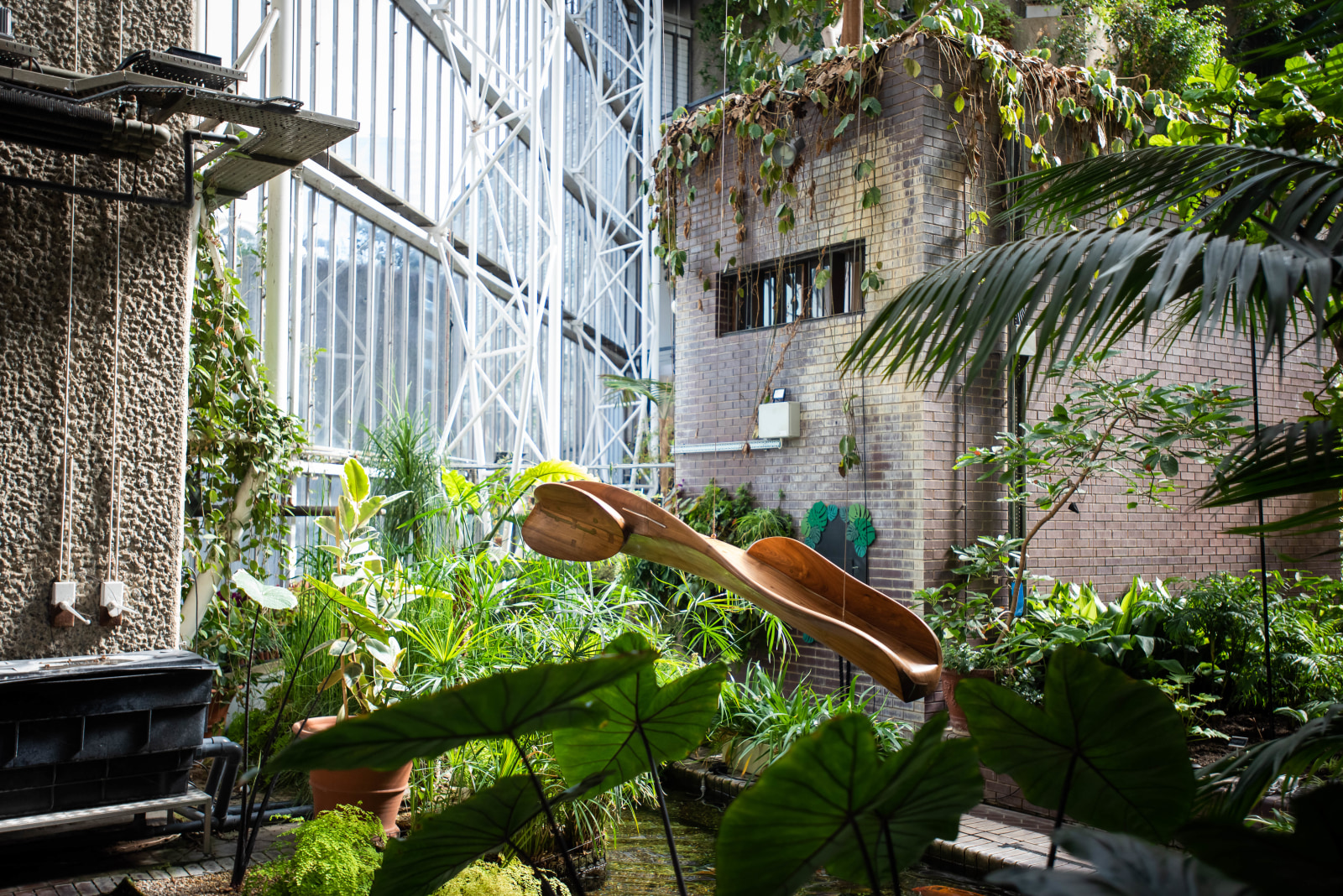
Above the crest | 2022
Site-specific sculptures interact with the Barbican Conservatory
Floating forms unfurl in Ranjani Shettar’s sculptural installation, Cloud songs on the horizon, responding both to the wildness of the conservatory’s planting and the surrounding Brutalist structure, writes Nyima Murry
By Nyima Murry
Through the swathes of plants, a series of new site-specific sculptures by Indian artist Ranjani Shettar in the Barbican's conservatory emerges as hanging orbs, extending tendrils and gliding gestures.
For the first time in the conservatory’s history, a programme of site-specific installations ‘allows artists to directly engage with the architecture and public spaces of this Modernist icon’ says Shanay Jhaveri, the Barbican’s recently appointed head of visual arts. As the inaugural show of this exciting new programme, Cloud songs on the horizon, installs a series of suspended sculptures that encourage visitors to discover the installation from multiple angles as they explore the space.
Entering from Level 4 of the arts centre and descending into the conservatory’s main atrium, the largest set of sculptures named Cloud songs on the horizon (from which the exhibition gets its name), burst through in a moment of synchronised bloom. The planting beds grow finder the further in you venture, before spewing out and over the seamless brick edges and sprawling up the plucked concrete walls. The sculptures follow suit to nestle themselves among the planting or unexpectedly spray out of the dense foliage. Over the koi pond, a smooth teak form hangs suspended as if gliding over the water, while a neighbouring sculpture Above the Crest extends as if an elaborate tangle of delicate tendrils to the ficus tree it hangs beside.
Although a clear process-led visual language is evident throughout the collection, each sculpture has been embedded into its context in different ways to create a series of exchanges between the conservatory’s planting, and the contrasting materiality of the Barbican’s concrete architecture. With views out on to the city and the Barbican’s residential towers from the greenhouse, it’s difficult to forget you’re in this Brutalist icon. The joy of Shettar’s installation is that it helps suspend belief for just that bit longer. The sculptures invite us to explore this well-known space with new eyes; lost in the tangle of plants searching for a glimpse of these earthly unfurling forms.
Sitting atop the main theatre and wrapping itself around the fly tower, the Barbican Conservatory houses over 1,500 species of plants and trees in its 2,100m2 space – making it the second largest conservatory in London after Kew Gardens. Opened to the public in 1982 as part of the Barbican Arts Centre, the conservatory has often been described as being at odds with the mass of grey concrete that surrounds it. The surrealness of this green oasis in the heart of the city is part of its charm – what other botanical garden would house plush Modernist leather sofas under their banana trees?
While the installation builds upon Shettar’s practice, which has developed over the last 20 years, the sculptures respond to the conservatory in a sensitive way to create this unique body of work. According to curator Jhaveri, the Barbican commissioned Shettar because of her practice’s ability to ‘transform enduring Modernist preoccupations, through a profound sensitivity for materials and a deep embodiment of an ecological consciousness’.
Shettar describes the distinctive abstract forms she is known for as ‘adaptations’, inspired by ‘meditating on the subjective unfolding of time in nature’. The work is moulded from stainless-steel bases and bound with handwoven muslin cloth, or carved out of a reclaimed teak pillar, employing techniques adapted from traditional Indian crafts that Shettar has developed in her workshop in rural Karnataka, India. Working with natural materials, the subtle addition of colour that spreads throughout the collection, graduates from the accented lacquer into pinky hues that have been created through using the harvested root of the madder plant and natural pomegranate dye.
There is a density to the installation that seems to differ from Shettar’s previously exhibited work but through the suspension of the sculptures at different heights manages to maintain this feeling of lightness. The resulting effect responds to the curated wildness of the planting in the conservatory and the dense solidity of the Barbican’s concrete frame - setting alight this relationship between the natural and the man-made.
Although Cloud Songs on the Horizon is Shettar’s first major institutional show in Europe, her work has previously been exhibited at New York’s Metropolitan Museum of Art, London’s Institute of Contemporary Arts and the Kiran Nadar Museum, New Delhi, to name but a few.
With the ambition of the Barbican’s visual arts programme to invite more contemporary artists from around the world to respond to the building’s unique architecture, Shettar’s installation is a bold start to what looks to be an ambitious series of site-sensitive installations.
View More on Architect's Journal